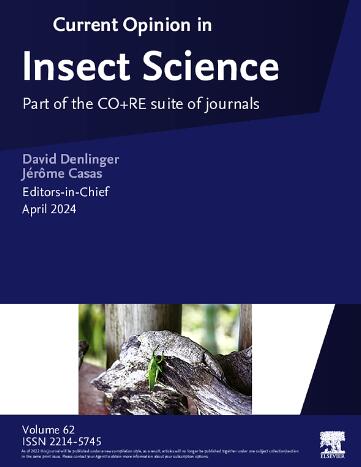飞蛾和蝴蝶的性别决定:雄性化是关键角色
IF 4.8
1区 农林科学
Q1 BIOLOGY
引用次数: 0
摘要
关于鳞翅目性别决定的知识在发现家蚕性别决定的主要触发因素十多年后才开始展开。家蚕具有w显性的性别决定机制,piwi相互作用RNA (piRNA)前体基因雌性化因子(Feminizer, Fem)是主要触发因子。新出现的观点是,尽管家蚕是模式生物,但它不适合预测其他鳞翅目物种的初级触发因素。然而,作为Fem piRNA在家蚕中的靶点,名为Masculinizer (Masc)的z连锁基因在迄今所研究的所有物种的性别决定中都起着关键作用。Masc在性别决定级联开始时的保守作用与已知的其他昆虫不同,在其他昆虫中,级联最初是多样化的,到最后变得越来越保守,双性(dsx)被交替地拼接成雌性或雄性变体。性别特异性的dsx剪接在鳞翅目中也是保守的,而其他构成性别决定级联的基因尚未被详细揭示。这两个物种的性别决定机制之所以受到重视,是因为与蚕不同,它们不依赖于来自W染色体的主要触发因素。Samia cynthia ricini蛾使用Z染色体与常染色体组的比例来确定性别。双环蝶(Bicyclus anynana)的性别决定更类似于蜜蜂,而不是蚕,它的一个高可变区域的合子性决定了个体是雌性还是雄性。本文章由计算机程序翻译,如有差异,请以英文原文为准。
Sex determination in moths and butterflies: Masculinizer as key player
Knowledge about sex determination in Lepidoptera is starting to unfold just over a decade after the discovery of the primary sex determination trigger in the silkworm Bombyx mori. The silkworm has a W-dominant sex determination mechanism with a PIWI-interacting RNA (piRNA) precursor gene called Feminizer (Fem) as the primary trigger. The emerging view is that the silkworm is unsuitable to predict primary triggers in other Lepidoptera species, despite its role as model organism. However, the Z-linked gene named Masculinizer (Masc), which is targeted by Fem piRNA in the silkworm, plays a key role in sex determination in all species studied so far. This conserved role of Masc at the beginning of the sex determination cascade differs from what is known in other insects, where the cascade is initially diverse and becomes increasingly conserved towards the end, where doublesex (dsx) is alternatively spliced into a female or male variant. Sex-specific dsx splicing is also conserved in Lepidoptera, while the other genes which make up the sex-determining cascade are yet to be revealed in full detail. The sex determination mechanisms in two species are highlighted because, unlike the silkworm, they do not rely on a primary trigger from the W chromosome. The moth Samia cynthia ricini uses the ratio of Z chromosomes to autosome sets to determine sex. The butterfly Bicyclus anynana has a sex determination more similar to the honey bee than to the silkworm, with the zygosity of a hypervariable region of Masc determining whether individuals become female or male.
求助全文
通过发布文献求助,成功后即可免费获取论文全文。
去求助
来源期刊

Current opinion in insect science
BIOLOGYECOLOGYENTOMOLOGY-ECOLOGY
CiteScore
10.40
自引率
1.90%
发文量
113
期刊介绍:
Current Opinion in Insect Science is a new systematic review journal that aims to provide specialists with a unique and educational platform to keep up–to–date with the expanding volume of information published in the field of Insect Science. As this is such a broad discipline, we have determined themed sections each of which is reviewed once a year.
The following 11 areas are covered by Current Opinion in Insect Science.
-Ecology
-Insect genomics
-Global Change Biology
-Molecular Physiology (Including Immunity)
-Pests and Resistance
-Parasites, Parasitoids and Biological Control
-Behavioural Ecology
-Development and Regulation
-Social Insects
-Neuroscience
-Vectors and Medical and Veterinary Entomology
There is also a section that changes every year to reflect hot topics in the field.
Section Editors, who are major authorities in their area, are appointed by the Editors of the journal. They divide their section into a number of topics, ensuring that the field is comprehensively covered and that all issues of current importance are emphasized. Section Editors commission articles from leading scientists on each topic that they have selected and the commissioned authors write short review articles in which they present recent developments in their subject, emphasizing the aspects that, in their opinion, are most important. In addition, they provide short annotations to the papers that they consider to be most interesting from all those published in their topic over the previous year.
 求助内容:
求助内容: 应助结果提醒方式:
应助结果提醒方式:


